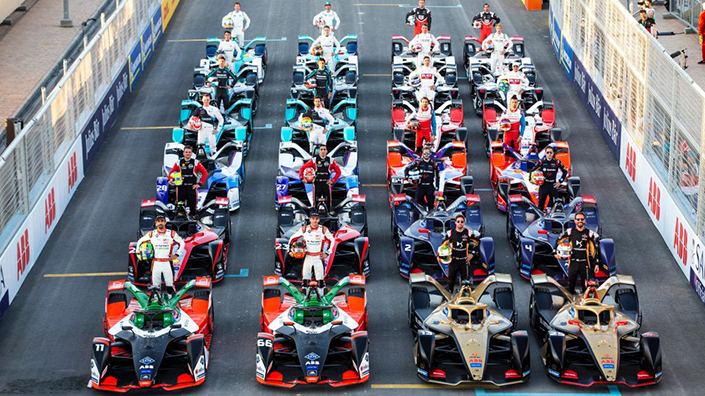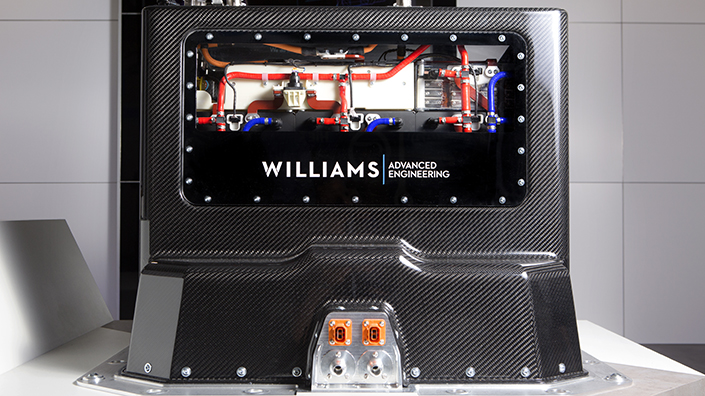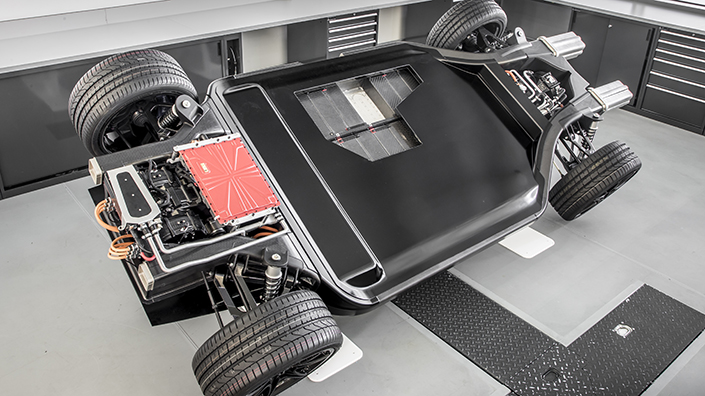There is a sense of inevitability, then, to the formation of Williams Advanced Engineering (WAE). Williams began diversifying in 2010, leading to the establishment of a WAE division, before it became its own limited company. All non-F1 business went over, and WAE head of motorsport Doug Campling moved across with his team in 2013, when the firm won the contract to build the first generation of Formula E batteries.
Four years earlier, Williams had done all its own work on a kinetic energy recovery system (Kers) for F1, including a flywheel-based design. WAE built on that, specialising in electrification and lightweighting, and was well-placed as the new electric series prepared to race.
Now the firm will supply batteries for four upcoming electric racing series – the third generation of Formula E, globe-hopping off-road series Extreme-E, upcoming touring car series ETCR and endurance championship LMDh.

WAE will supply the batteries for the third generation of Formula E
Each of those series put wildly different demands on their battery systems, pushing WAE to overcome major challenges with new ideas and techniques. The firm’s advanced engineering is not limited to motorsport, however – as sectors from aerospace to marine join the journey to ‘net zero’, its innovation is finding wider application.
WAE picked up this varied set of racing contracts thanks to its deep in-house capabilities in Grove, Oxfordshire. It can manufacture a few thousand top-end batteries each year, fine-tuning them in its testing facilities. It can build complete vehicles, using strong aerodynamics facilities for R&D. Its F1 heritage provides vehicle dynamics capabilities, as well as small-scale manufacturing.
The battery manufacturing, a unique capability for a motorsport consultancy, includes associated technology such as safety enclosures and battery management systems (BMS). The firm builds bespoke modules, delivering the perfect blend of weight and energy density for the task.
Put simply, it is perfectly positioned at the head of the electrification pack. “We were the only team that made our own batteries, e-machines, inverters, right from the start,” says Campling. “So we had this incredible head start in the role.”
Technology in each of the motorsport batteries can be traced back through WAE’s projects, including work with Porsche and F1 teams. “There’s a real thread of DNA, especially around the BMS,” says Campling.
The firm’s experience with Kers, which historically used space-efficient pouch cells – similar to those found in drones and other hobby electronics – is also valuable, as is its in-house capabilities. Modern racing series can support exotic cell chemistry, and WAE is keen to innovate.
The different demands of the four series have an enormous effect on cell development and selection. In general, hybrid systems need very high power density, while batteries for pure-electric vehicles need to provide as much duration as possible out of the packaging volume.
Bespoke chemistries
There are effectively two types of battery cell, says Campling – mass-produced, which are acceptable for many applications, and cells with bespoke chemistries. “Those have a huge cost implication,” he says. “When you move to the bespoke cells, you might be talking about a seven-to-10 multiple on cell pricing. But with that you get a very significant increase in the performance directly, often within the packaging as well.”
Lightweighting is key – batteries are, after all, a heavier energy storage method than petrol or diesel. Customers and WAE also have to balance the elements of density when developing and selecting batteries. Power density and energy density both have a volumetric and gravimetric basis, and the balance between them is juggled depending on the application.
Of the four series, ETCR and Extreme-E are the most similar. The ETCR battery provides peak power of 500kW and 300kW continuous power, with 62kWh capacity for a 21-minute race. It also allows four ‘push to pass’ overtakes. Extreme-E uses 54kWh packs, with maximum output of 470kW.

WAE's Multi-Chem, which uses a bi-directional DC/DC converter and combines two different types of cell (Credit: WAE)
Neither is a truly efficiency-based series, says Campling, and there is no in-race energy management. The focus is instead on allowing teams to go full power throughout.
In the first generation of Formula E, there was a simple solution to the batteries’ inherent limits – during the 45-minute races, drivers would stop and change car. In the second generation, the battery lasted the whole race.
In the third generation the bespoke batteries will be lighter and smaller, according to Motorsport.com, and the series will reportedly feature pit-stop fast charging for the first time. According to The Race, charges will last approximately 30 seconds with power ratings of 600-800kW.
WAE is unable to comment on any details of the Gen Three Formula E batteries, but Campling adds: “Suffice to say it is a challenge we relish, that plays to our core skills.”
High-speed safety
Safety is of paramount importance for motorsport batteries. Misuse – such as over-charging – can lead to ‘thermal events’ such as thermal runaway, where increasing temperature releases more energy, which in turn increases the temperature. These risks are covered by the BMS, says Campling, and “robust” failure mode and effects analysis on the BMS itself. The cars themselves include some clever safety features in case of a thermal event, which can release flammable gas. There is also the clear risk of battery penetration in the event of a crash. Each series provides its own type of physical protection to the battery, with strategically placed Kevlar-based carbon composites, a common choice for kinetic protection.
“We developed countermeasures within Formula E Gen One to allow a battery to be flooded externally, for gas pressure to be released before it damaged the enclosure, and hot gas to be released in a controlled way,” says Campling. “We have pressure relief valves, burst discs, douse-ports, snorkels – all sorts of interventions there to control a thermal event should it happen.”
Electrocution is the final big threat. In racing, it is tackled with three levels of isolation protection – an equipotential bonding strategy to stop it getting close to capacitive coupling, high-voltage interlocks and isolation protection in the BMS. The BMS itself has a back-up battery showing the isolation status of the car for 15 minutes after an incident, keeping marshals safe.
Transformative engineering
Of course, after its separation from Williams, WAE is not solely focused on motorsport. Technology transfer from motorsport to high-performance automotive has been “a well-trodden path over the last century,” says technical director Paul McNamara.
The firm’s most cutting-edge technology will have an even wider influence in the years to come, as motorsport technology is gradually adapted for consumer cars and other engineering sectors.
“The technologies that tend to flow down from electric motorsport series are the control systems that are maximising the energy you can extract compared to the life of the cells and the speed with which you can charge them,” says McNamara. “If you can have confidence you can go into a petrol station and put a decent amount of charge into your battery in three or four minutes, then that’s rather transformative.”
Fast charging, which could reduce ‘range anxiety’ felt by potential buyers, will be enabled by better cooling technology and control systems – both areas of focus at WAE. The optimisation of motorsport battery BMS code, including safety modelling, lifecycle analytics and control algorithms, is another commercially appealing advance.

The FW-EVX electric car platform includes crash-resistant folded carbon fibre (Credit: WAE)
The company’s focus on lightweighting includes materials and manufacturing techniques with great promise in mainstream automotive. Its FW-EVX electric car platform project, for example, included proprietary innovations. The carbon-fibre chassis and battery housing was built using WAE’s patented 223TM technology, which folds the material to create light, crash-resistant structures.
For Campling, it is the ‘top level’ approach of designing an EV from the ground up that will be electric motorsport’s biggest influence on car manufacturers, instead of simply adding batteries and motors to existing models. This, he feels, will lead to a more mature approach to desirable metrics, moving beyond just range to an equivalent of miles per gallon. Once that happens, he predicts that manufacturers will be tempted to “nibble away” at safety tolerances, reducing weight and extracting more for less – WAE’s speciality.
Diverse applications
While automotive is an obvious route for WAE’s technology, electrification is increasingly transforming other sectors. The firm is working on projects in aerospace, mining and marine engineering, all areas where battery technology was impractical for many decades. It is also developing and supplying electric scooters for the new eSkootr race series.
The firm’s advanced techniques, including innovative control systems and decentralised batteries to manage weight distribution, could be applied throughout engineering. Working with BAE Systems, for example, WAE has explored the concept of separate batteries for different uses in future fighter jets.
“The cells in each of the blocks distributed around the aircraft would be different – some focused on energy storage, and some focused on power delivery,” says McNamara. “You can almost select the type of cell for the particular application you’re looking at but still manage the energy in total across the whole system, which we think is super innovative.” The idea follows on from the firm’s Multi-Chem project, which used a bi-directional DC/DC converter and two different types of cell to overcome the perennial compromise between energy and power density.
In a pleasingly circular fashion, systems developed in the BAE project could flow from combat aircraft to commercial aerospace, and potentially back into motorsport. Despite blazing its own trail, the intrinsic link between motorsport and engineering is not going anywhere at Williams Advanced Engineering.
Read more: Williams Advanced Engineering electrifies fighter jet, mining truck and yacht
Want the best engineering stories delivered straight to your inbox? The Professional Engineering newsletter gives you vital updates on the most cutting-edge engineering and exciting new job opportunities. To sign up, click here.
Content published by Professional Engineering does not necessarily represent the views of the Institution of Mechanical Engineers.